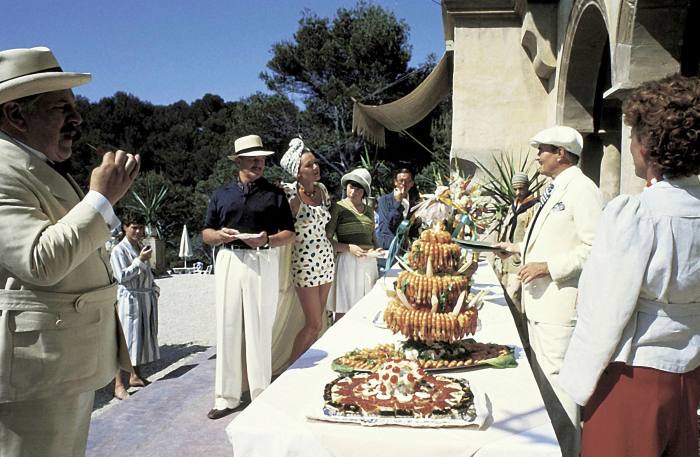Do you ever get inspiration from interiors shown in films or television? If so, which?
A brilliant question. Films and television programmes are all about creating the right kind of atmosphere, and so it is with interiors. I design interiors for hotels and restaurants — pure theatre — so where better to look for inspiration than the stage and screen? Here are some of my favourite dramatic moments, interiors, moods . . .
The films of Luca Guadagnino: 2009’s I Am Love was filmed at Villa Necchi Campiglio, a 1930s mansion in the heart of Milan designed by the architect Piero Portaluppi. Surrounded by sprawling gardens, it’s the epitome of Italian chic: all rich walnut floors and marble staircases. It never fails to impress; every time I walk through the gates I’m imagining how glamorous, ultra-modern and otherworldly it must have felt, arriving at the house for a party in the 1930s.
All of the villa’s details were designed by Portaluppi, with postwar updates by Tomaso Buzzi: there are German silver sliding doors and star-shaped windows, there is a bathroom clad in black glass tiles. Tilda Swinton’s colourfully slick wardrobe of Raf Simons for Jil Sander almost outshone the villa on screen, but not quite.
Of course I can’t discuss Guadagnino without mentioning Call Me By Your Name. I adored André Aciman’s book (obviously) when I first came across it in a West Village bookstore years ago, and was thrilled when the adaptation came out. In fact, it is probably the film I’ve been most excited about seeing for a long time now — I was quivering in my seat when the titles rolled.
For the film, the action was moved from the Ligurian coast to the Lombardy hills, and according to AnOther magazine, when they found the right house to shoot in, Guadagnino and his team (including set designer Violante Visconti di Modrone) worked together “to cultivate an atmosphere of languorous sensuality, iridescent with sunshine and sexual promise”. (Much more breezy compared with the restrained, almost cold beauty of I Am Love.)
I pored over every room and garden corner, and in fact there are too many scenes to mention: pale mint tiles and a coral bath mat in a bathroom; the perfectly imperfect Italian country kitchen with its assorted clutter; terrazzo floors and squishy armchairs clothed in arsenic green slipcovers.
Wes Anderson: in every one of Anderson’s films there is an entire universe that I want to get lost in. Take 2014’s The Grand Budapest Hotel: how I pine to holiday at that old dame! Görlitz, a cavernous former department store building (one of the best preserved from the early 20th century), situated in the German town of the same name, served as the location for many of the sets in The Grand Budapest Hotel, its fabulous Art Nouveau stairways, elevators and atrium being the stars.
An important theme of the film is the idea of a forgotten, glamorous world, all pastel colours, elegantly tailored uniforms and, as the title suggests, grand old hotels. It is pure confectionery, and very much up my strasse.

The Darjeeling Limited is another Anderson piece of magic, set mostly on a train as it snakes its way through the Indian countryside. The colours dazzle (a plethora of intense oranges, yellows and blues) and I love the geometric patterns plastered on everything from the train’s seats and curtains to its walls and carpets. (It is in fact now possible to travel on a Wes Anderson-designed train carriage in real life. Call Belmond.)
What other on-screen inspiration springs to mind? The 1981 television adaptation of Brideshead Revisited, for one. Production designer Peter Phillips was responsible for the sets of some key episodes: Castle Howard in Yorkshire stood in for Brideshead, and how about all those wonderful scenes set in Oxford (white tablecloths and flickering candles, panelled rooms and groaning platters of plover’s eggs) and Venice (crisp linen and cupolas)?
Look, I have an enormous soft spot for Agatha Christie. I’m working on a restaurant project, and when I’m considering the atmosphere I want to conjure, I often think back to elegant moments I’ve mentally noted during our lockdown binges on the television series: I’m talking dining rooms on trains and boats, lampshades casting a soft glow over silver bud vases stuffed with yellow irises.

Nothing, however, compares to the utter perfection that is the 1982 film version of Evil Under the Sun. An impeccable cast, yes. (Maggie Smith! Diana Rigg! Jane Birkin!) Fabulous costumes, absolutely. But the film’s setting, a hotel on an island in the Adriatic Sea (Smith plays the acid-tongued landlady), steals the show (like Budapest) with its terraces and faded pink paintwork, its columns and glittering chandeliers, fringed slipper chairs and trays of pale blue cocktails.
I’m running out of space and I haven’t even got to Luchino Visconti yet. And what about Hobbiton? The interiors of Bag End are extremely close to my heart. I am such a hobbit. One last thing: yes I love a ballroom on a liner, a crumbling palazzo, but I have to admit that I’ve also always been a little bit fascinated by spaceship interiors. All that shiny silver, and doors that make a swooshing sound when they open automatically? Pretty cool actually.
If you have a question for Luke about design and stylish living, email him at [email protected]. Follow him on Instagram @lukeedwardhall
And to find out about our latest stories first, follow @FTProperty on Twitter or @ft_houseandhome on Instagram